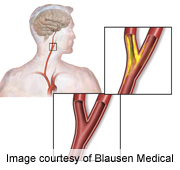Cost-effective tool for prevention of stroke in asymptomatic patients with carotid artery stenosis
THURSDAY, Jan. 29, 2015 (HealthDay News) — A decision rule based on assessment of cerebrovascular reserve (CVR) seems to be cost-effective for prevention of stroke in asymptomatic patients with carotid artery stenosis, according to a study published in the February issue of Radiology.
Ankur Pandya, Ph.D., from the Weill Cornell Medical College in New York City, and colleagues compared the cost-effectiveness of three strategies in asymptomatic patients with carotid artery stenosis for prevention of stroke. Immediate revascularization (carotid endarterectomy) and ongoing medical therapy (with antiplatelet, statin, and antihypertensive agents plus lifestyle modification) were compared with use of a CVR-based decision rule for treatment (patients with CVR impairment undergo immediate revascularization and others receive medical therapy). The authors projected lifetime quality-adjusted life-years (QALYs) and costs for patients with carotid stenosis with 70 to 89 percent carotid luminal narrowing at presentation using a decision analytic model.
The researchers found that the total costs per person and lifetime QALYs were lowest for the medical therapy-based strategy ($14,597; 9.848 QALYs), followed by CVR testing ($16,583; 9.934 QALYs), with the highest costs per person and lifetime QALYs for immediate revascularization ($20,950; 9.940 QALYs). The incremental cost-effectiveness ratio was $23,000 per QALY for the CVR-based strategy versus medical therapy-based strategy, and $760,000 per QALY for immediate revascularization versus the CVR-based strategy.
“CVR testing can be a cost-effective tool to identify asymptomatic patients with carotid stenosis who are most likely to benefit from revascularization,” the authors write.
Full Text (subscription or payment may be required)
Copyright © 2015 HealthDay. All rights reserved.








